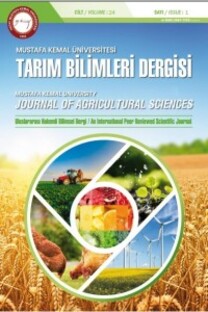Seralarda soğutma pedi olarak bazı yerel malzemelerin uygunluklarının değerlendirilmesi
Determination of the suitability of some local materials as cooling pad in greenhouses
___
- Ahmed EM, Abaas O, Ahmed M, Ismail MR (2011) Performance evaluation of three different types of local evaporative cooling pads in greenhouses in Sudan. Saudi Journal of Biological Sciences 18: 45–51.
- Alodan MA, Al-Faraj AA (2005) Design and evaluation of galvanized metal sheets as evaporative cooling pads. J. King Saud Univ, 18: Agric Sci 1: 9-18.
- Atılgan A, Oz H (2007) Serin iklime sahip bölgelerdeki seralarin fan ped sistemiyle serinletilmesi. Derim Batı Akdeniz Tarımsal Araştırma Enstitüsü Dergisi 24(1): 11-18.
- Dzivama AU, Bindir UB, Aboaba FO (1999) Evaluation of pad materials in construction of active evaporative cooler for stroge of fruits and vegetables in arid environments. Agricultural Mechanization in Asia, Africa and Latin America, AMA, 30(3): 51-55.
- Elmsaad E, Omran A (2015) Evaluating the effect of new local materials of evaporative cooling pads. American-Eurasian J. Agric. & Environ. Sci. 15(1): 78- 84.
- Erbil FG, Atılgan A (2014) Sıcak bölgelerdeki seralarda fan-ped sisteminin etkinliğinin belirlenmesi. Süleyman Demirel Üniversitesi Ziraat Fakültesi Dergisi, 9(1): 34-41.
- Franco A, Valera DL, Peña A (2014) Energy efficiency in greenhouse evaporative cooling techniques: cooling boxes versus cellulose pads. Energies 7: 1427-1447.
- Gunhan T, Demir V, Yagcioglu AK (2007) Evaluation of the suitability of some local materials as cooling pads. Biosystems Engineering 96(3): 369–377.
- Helmy MA, Eltawil MA, Abo-shieshaa RR, El-Zan NM (2013) Enhancing the evaporative cooling performance of fan-pad system using alternative pad materials and water film over the greenhouse roof. Agric Eng Int: CIGR Journal, 15(2):173-187.
- Jain JK, Hindoliya DA (2014) Correlations for saturation efficiency of evaporative cooling pads. J. Inst. Eng. India Ser. C 95(1): 5–10.
- Kittas C, Bartzanas T, Jaffrin A (2003) Temperature gradients in a partially shaded large greenhouse equippedwith evaporative cooling pads. Biosystems Engineering 85(1): 87–94.
- Kulkarni MM, Vijaykumar KN, Jadhav NA, Bhor MJ, Shinde SS (2015) Experimental performance evaluation of new cooling pad material for direct evaporating cooling for pune summer conditions. International Journal of Engineering Trends and Technology 22(6): 281-287.
- Maurya R, Shrivastava N, Shrivastava V 2014. Performance evaluation of alternative evaporative cooling media. International Journal of Scientific & Engineering Research 5(10): 676-684.
- Öztürk HH (2004) Venlo tip cam serada fan-ped serinletme sisteminin etkinliği ile duyulur ve gizli isi transferi. Tarım Bilimleri Dergisi 10(4): 381-388.
- Vala KV, Kumpavat MT, Nema A (2016) Comparative performance evaluation of evaporative cooling local pad materials with commercial pads. International Journal of Engineering Trends and Technology 39(4): 198-203.
- Von Zabeltitz C 1994. Effective use of renewable energies for greenhouse heating. Renewable Energy, 5(1-4): 479-485.
- Warke DA, Deshmukh SJ (2017) Experimental analysis of cellulose cooling pads used in evaporative coolers. International Journal of Energy Science and Engineering 3(4): 37-43.
- Xu J, Li Y, Wang RZ, Liu W, Zhou P (2015) Experimental performance of evaporative cooling pad systems in greenhouses in humid subtropical climates. Applied Energy 138: 291-301.
- ISSN: 1300-9362
- Yayın Aralığı: Yılda 3 Sayı
- Başlangıç: 1996
- Yayıncı: Mustafa Kemal Üniversitesi Ziraat Fakültesi
TR63 bölgesi iklim koşullarının seracılık açısından irdelenmesi
A. Nafi BAYTORUN, Adil AKYÜZ, Ali ÇAYLI, Sait ÜSTÜN
İlaçlama işleminde GNSS esaslı traktör otomatik dümenleme sistemlerinin etkinliği
Muharrem KESKİN, Mustafa TOPÇUERİ
Elmaların (Malus communis L.) bazı fiziksel değişimlerine farklı kurutma koşullarının etkisi
Bünyamin DEMİR, Cevdet SAĞLAM, Necati ÇETİN
Rabia ÇALIŞKAN, Kenan BÜYÜKTAŞ, Ahmet TEZCAN, Cihan KARACA
Effectiveness of GNSS-based tractor auto steering systems in crop spraying
Mustafa TOPÇUERİ, Muharrem KESKİN
C. Sabahattin ONCEL, Mladen TODOROVİC, A. Halim ORTA
Domates ve biber rizosfer topraklarında kalsiyum (Ca) uygulamalarının R/S değerlerine etkisi
Kemal DOGAN, Sefer BOZKURT, Necat AGCA
M9 anacı üzerine aşılı mondial gala elma çeşidinin Akdeniz bölgesindeki performansı
Safder BAYAZİT, Derya KILIÇ, Kazim GÜNDÜZ
Hatay baklagil ekim alanlarında rhizobial potansiyellerin belirlenmesi
